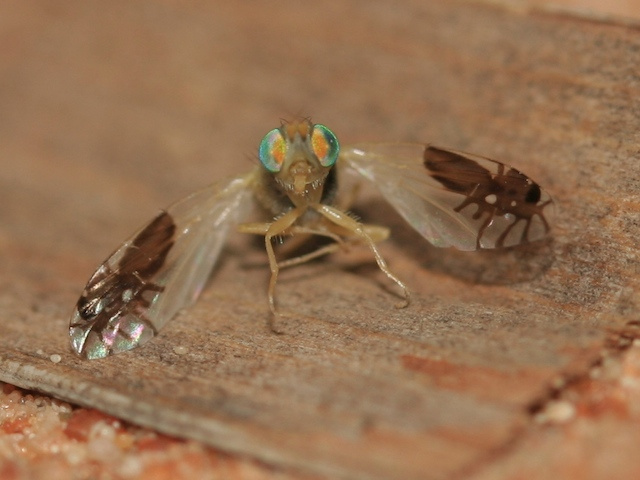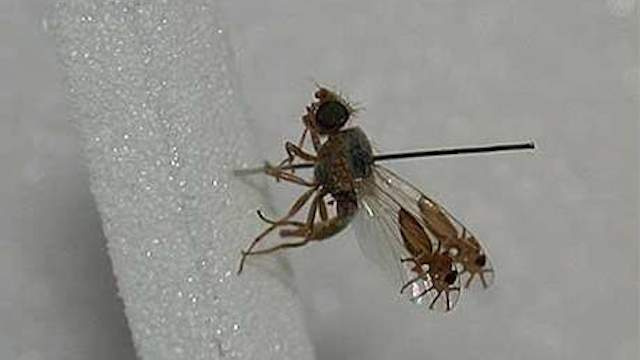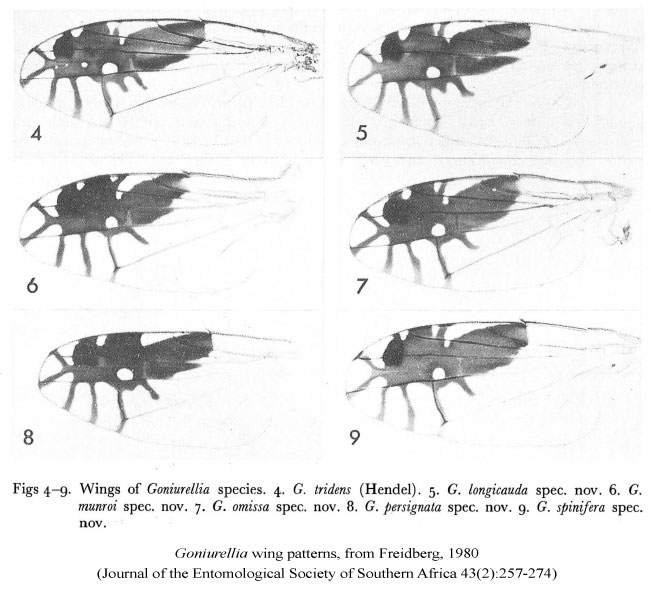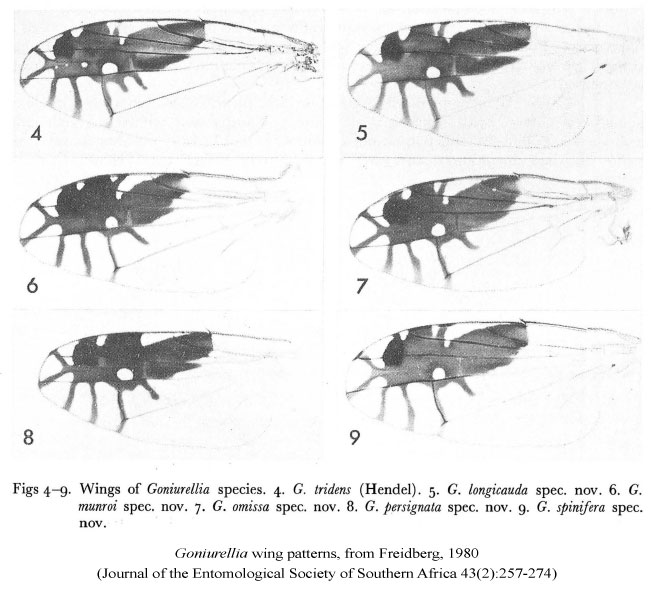It looks like you're using an Ad Blocker.
Please white-list or disable AboveTopSecret.com in your ad-blocking tool.
Thank you.
Some features of ATS will be disabled while you continue to use an ad-blocker.
share:
I searched on the insect name and couldn't find it, but it could be somewhere in the ATS archives.
Pretty damn amazing right there... a lot of speculation as to what they are intended for, but nature never ceases to amaze me. These are just patterns found in specific insects, but they are uncanny in their resemblance to another insect.
Meet Goniurellia Tridens:


Gizmodo
Biodiversity
~Namaste
Pretty damn amazing right there... a lot of speculation as to what they are intended for, but nature never ceases to amaze me. These are just patterns found in specific insects, but they are uncanny in their resemblance to another insect.
Meet Goniurellia Tridens:


It’s possible that the wing patterns together are serving as a false-head (as suggested to me by Richard Jones on Twitter), and thus tricking predators into attacking the wing tips first (which would still be bad for the fly’s ability to fly) or into attacking the false-head from “behind”, thus putting them squarely in front of the true head and easily watched and avoided by the fly. This strikes me as a pretty reasonable argument, but why might there be so much variation in wing patterns if species are using them as a false head?
Gizmodo
Biodiversity
~Namaste
reply to post by SonOfTheLawOfOne
Yeah, that's kind of a stupid adaptation. More likely to get eaten, but maybe birds and other insect eaters think the "ants" are unappetizing and keep away from what they perceive as a group of three. Since the insect has survived, it must be a defense of some kind. Doesn't even look real, but you vouch for it. A strange looking insect though.
Yeah, that's kind of a stupid adaptation. More likely to get eaten, but maybe birds and other insect eaters think the "ants" are unappetizing and keep away from what they perceive as a group of three. Since the insect has survived, it must be a defense of some kind. Doesn't even look real, but you vouch for it. A strange looking insect though.
reply to post by SonOfTheLawOfOne
Nature never ceases to amaze me. So did this fly just evolve or something? How does the DNA know to do this is just beyond me.
Nature never ceases to amaze me. So did this fly just evolve or something? How does the DNA know to do this is just beyond me.
wow,
the matrix really know how to play the mind...
cool adaptation i must say
kinda like an auto imprinted tattoo
the matrix really know how to play the mind...
cool adaptation i must say
kinda like an auto imprinted tattoo
edit on 13-11-2013 by Lil Drummerboy because: (no reason given)
FlySolo
reply to post by SonOfTheLawOfOne
Nature never ceases to amaze me. So did this fly just evolve or something? How does the DNA know to do this is just beyond me.
That is what truly amazes me! How could DNA get feedback like that? Wouldn't it require a third person (entity) viewpoint of the world? and how would the information be transmitted back to the cell as well as the logic process taking place that introducing models of ants would make an effective camo ? Absolutely astounding and goes to show that we know so little about the evolution process.
reply to post by SonOfTheLawOfOne
It almost looks like two ants are fighting over a meal or bringing one home. I wonder if ants leave other ants who are carrying food alone just by sight? Do the ants that the image is mimicking sting fiercely? That could ward off predators...
It almost looks like two ants are fighting over a meal or bringing one home. I wonder if ants leave other ants who are carrying food alone just by sight? Do the ants that the image is mimicking sting fiercely? That could ward off predators...
On first thought, wow DNA is ...thinking. Then again there's the possibly that the wing patterns remained hereditary as more of the fruit flies that
were not eaten or attacked with a certain pattern each one stronger than the next resembling an ant. With that would have more to do with what the
predator is seeing as opposed to DNA engineering(?) the pattern. Or that it would be as mentioned in the OP article, mating preference.
edit
on 13-11-2013 by dreamingawake because: correction
Maybe it's not a defense system against an aggression, but one to allow the fly to mix with ants to collect some food, without being attacked?
A kind of situational "passe-partout".
A kind of situational "passe-partout".
California had an infestation of these things in the 80's but I never got a close up look at one until now. It almost looks fake but they develop
markings as a way to survive so why not a couple of ants. I am wondering if this particular fruit fly is just an anomaly with how clear these markings
are.
Ants like fruits and sweet stuff too so I really am not sure what the purpose would be. I would think an insect is an insect if it's flying (to a bat for example), so they would have to sit down to truly take on the illusion of being an ant. And predators don't have electron microscope vision so are they eyeing each insect before they choose each bite? I'm sure someone out there will figure it out.
Ants like fruits and sweet stuff too so I really am not sure what the purpose would be. I would think an insect is an insect if it's flying (to a bat for example), so they would have to sit down to truly take on the illusion of being an ant. And predators don't have electron microscope vision so are they eyeing each insect before they choose each bite? I'm sure someone out there will figure it out.
NowanKenubi
Maybe it's not a defense system against an aggression, but one to allow the fly to mix with ants to collect some food, without being attacked?
A kind of situational "passe-partout".
That's a good theory. Would the ants be oblivious though? Probably.
reply to post by SonOfTheLawOfOne
Animals will devlope to mimick and deter their predators. Been happening forever! It is natures way.
Silly example:
Dumb example I know - but I didn't know of specific insect examples.. My bad.
Animals will devlope to mimick and deter their predators. Been happening forever! It is natures way.
Silly example:
Dumb example I know - but I didn't know of specific insect examples.. My bad.
dreamingawake
On first thought, wow DNA is ...thinking. Then again there's the possibly that the wing patterns remained hereditary as more of the fruit flies that were not eaten or attacked with a certain pattern each one stronger than the next resembling an ant. With that would have more to do with what the predator is seeing as opposed to DNA engineering(?) the pattern. Or that it would be as mentioned in the OP article, mating preference.edit on 13-11-2013 by dreamingawake because: correction
I agree that this is the only method that makes sense, knowing what we do about evolution. It is still astounding, as it must start from a "clean slate", and uses attrition over long periods of time to develop the legible images.
There must be a random wing colorization attribute in the DNA. This says that the company of ants is the most important aspect in it's continued success as a species, but there was no pre-conceived plan to paint the ants in it's wings. Incredible.
When you consider the entire species, it's not that unique. It's neat still, but it's just how winged insects have evolved.
www.biodiversityinfocus.com...

A good, unbiased, article on it. Always pays to think about things and not ask questions that have no answers such as "doesn't it need a third person to tell it what to look like?" when.. no, it doesn't. Nature has had a long time to make random things into ordered patterns.
www.biodiversityinfocus.com...
This stellate (star-like) wing pattern is very common among flies in the Tephritinae, the subfamily of fruit flies this species belongs to, although the specifics differ between species and genera. Here are the wing patterns of the other Goniurellia species (found across the Mediterranean, Middle East, Africa and Asia).

A good, unbiased, article on it. Always pays to think about things and not ask questions that have no answers such as "doesn't it need a third person to tell it what to look like?" when.. no, it doesn't. Nature has had a long time to make random things into ordered patterns.
reply to post by SonOfTheLawOfOne
The species was described by Hendel around 1910 and if I understand correctly isn't actually a fruit fly, it's a false fruit fly. Wing photos were published by Friedberg in 1980, an excerpt is here: Picture Wing Fly
As can be seen below, from Freidberg's work, the #4 pattern doesn't look all that much like an ant. The photos going around on the web have the wings pulled into a position which is not natural for the fly but does leave one with the impression that it looks more like an ant or spider than it does in real life. Nice trick photography.
I was not able to find this exact species with the wings folded on it's back. In that position though, it would look like the "ants" are standing on each other's feet -- meaning it doesn't look ant-like at all. It's more like two blobs with connecting lines between the blobs. This makes more sense, because the presence of several bugs would just indicate more "lunch" to a predator than a single bug. It's most likely just camouflage as would be typical. If it does shake it's wings while trying to get away, it probably looks more like a spider or two getting ready to attack than two ants walking side by side. Many birds have blind spots straight ahead, so again a threatening spider makes more sense than ants.

The species was described by Hendel around 1910 and if I understand correctly isn't actually a fruit fly, it's a false fruit fly. Wing photos were published by Friedberg in 1980, an excerpt is here: Picture Wing Fly
As can be seen below, from Freidberg's work, the #4 pattern doesn't look all that much like an ant. The photos going around on the web have the wings pulled into a position which is not natural for the fly but does leave one with the impression that it looks more like an ant or spider than it does in real life. Nice trick photography.
I was not able to find this exact species with the wings folded on it's back. In that position though, it would look like the "ants" are standing on each other's feet -- meaning it doesn't look ant-like at all. It's more like two blobs with connecting lines between the blobs. This makes more sense, because the presence of several bugs would just indicate more "lunch" to a predator than a single bug. It's most likely just camouflage as would be typical. If it does shake it's wings while trying to get away, it probably looks more like a spider or two getting ready to attack than two ants walking side by side. Many birds have blind spots straight ahead, so again a threatening spider makes more sense than ants.

winofiend
When you consider the entire species, it's not that unique. It's neat still, but it's just how winged insects have evolved.
Winofiend -- looks like I should have refreshed prior to posting! You beat me to the photos! Good catch, I know this isn't the first time you have done your homework prior to posting. That's a good habit IMO and a rare enough one it is to be commended.
It takes me a while still to get the photos embedded in ATS.... I have all my website history turned off and I keep having to rediscover the links. Then Windows rebooted to install some updates. After installing, amazingingly, I was still logged in. I don't fully understand how the login persisted, but I'm happy it did.
As you no doubt found, there were several sites with the same excerpt from Friedberg. At least one had a photo of another close member in the family with the wings folded as is normal for the fly; there was nothing remotely ant-like in that photo. Merely two dark blobs with dark lines between them.
I was really bothered by the presentation in the photos AND that it was being labeled as a discovery by many news forums. I actually wondered if there was some photoshopping going on! Maybe ATS has heightened my suspicion of forums and news sources copying each other without checking the evidence??? Anyway, it turned out to be just a combination of unnatural presentation and suggestion.
I did enjoy reading a few journal articles though -- that's a good thing.
charlyv
I agree that this is the only method that makes sense, knowing what we do about evolution. It is still astounding, as it must start from a "clean slate", and uses attrition over long periods of time to develop the legible images.
Darwin's version of evolution, which was a naturalized version of selective breeding, was replaced long ago by a version of mutations plus survival of the fittest. More modern concepts of evolution really revolve around random mutations, and random survival events, mating attractiveness, plus environmental acquired adaptations (gene methylation) all affecting birth and death rates. Not all that long ago, inheritance of acquired characteristics was a major non-no. That's no longer the case.
In any case, given enough time, one physical version will dominate to the extent that other versions are rare in comparison (and may be extremely difficult to detect) whether the "winner" is technically the most fit for the environment or not. It may not be the predators driving this result; it might be the attractiveness of particular patterns to potential mates or ability to cool or absorb heat in over particular regions of the body.....
Scaring away, or confusing, predators is just a nice story that fits what we hear in grammar school. Developing definitive evidence to support any particular supposition isn't easy nor is a "thought experiment" science per se. The pattern on the wing is the fact, all the rest is mere supposition.
reply to post by dreamingawake
I can go with that explanation.
Like Hamlet said, "There are more things in heaven and earth, Horatio, than are dreamt of in your philosophy."
On first thought, wow DNA is ...thinking.
I can go with that explanation.
Like Hamlet said, "There are more things in heaven and earth, Horatio, than are dreamt of in your philosophy."
It seems like the fly's bodies were superimposed on to the wings, like when it was still young and maturing(during the time where the wings wrap
around the body), it does not look like ants.
Those are spiders, actually. Ants aren't quite as effective at warding off predators as illusory spiders.
new topics
-
BIDEN Admin Begins Planning For January 2025 Transition to a New President - Today is 4.26.2024.
2024 Elections: 2 hours ago -
Big Storms
Fragile Earth: 4 hours ago -
Where should Trump hold his next rally
2024 Elections: 7 hours ago -
Shocking Number of Voters are Open to Committing Election Fraud
US Political Madness: 7 hours ago -
Gov Kristi Noem Shot and Killed "Less Than Worthless Dog" and a 'Smelly Goat
2024 Elections: 8 hours ago -
Falkville Robot-Man
Aliens and UFOs: 8 hours ago -
James O’Keefe: I have evidence that exposes the CIA, and it’s on camera.
Whistle Blowers and Leaked Documents: 9 hours ago -
Australian PM says the quiet part out loud - "free speech is a threat to democratic dicourse"...?!
New World Order: 10 hours ago -
Ireland VS Globalists
Social Issues and Civil Unrest: 10 hours ago -
Biden "Happy To Debate Trump"
2024 Elections: 11 hours ago
top topics
-
James O’Keefe: I have evidence that exposes the CIA, and it’s on camera.
Whistle Blowers and Leaked Documents: 9 hours ago, 17 flags -
Australian PM says the quiet part out loud - "free speech is a threat to democratic dicourse"...?!
New World Order: 10 hours ago, 15 flags -
Blast from the past: ATS Review Podcast, 2006: With All Three Amigos
Member PODcasts: 13 hours ago, 13 flags -
Biden "Happy To Debate Trump"
2024 Elections: 11 hours ago, 13 flags -
Ireland VS Globalists
Social Issues and Civil Unrest: 10 hours ago, 9 flags -
Mike Pinder The Moody Blues R.I.P.
Music: 13 hours ago, 8 flags -
Shocking Number of Voters are Open to Committing Election Fraud
US Political Madness: 7 hours ago, 6 flags -
BIDEN Admin Begins Planning For January 2025 Transition to a New President - Today is 4.26.2024.
2024 Elections: 2 hours ago, 6 flags -
What is the white pill?
Philosophy and Metaphysics: 12 hours ago, 6 flags -
RAAF airbase in Roswell, New Mexico is on fire
Aliens and UFOs: 11 hours ago, 5 flags
active topics
-
BIDEN Admin Begins Planning For January 2025 Transition to a New President - Today is 4.26.2024.
2024 Elections • 15 • : theatreboy -
RAAF airbase in Roswell, New Mexico is on fire
Aliens and UFOs • 12 • : pianopraze -
A Warning to America: 25 Ways the US is Being Destroyed
New World Order • 29 • : 19Bones79 -
Big Storms
Fragile Earth • 15 • : Caver78 -
What is the white pill?
Philosophy and Metaphysics • 22 • : AlexandrosOMegas -
University of Texas Instantly Shuts Down Anti Israel Protests
Education and Media • 315 • : CriticalStinker -
Gov Kristi Noem Shot and Killed "Less Than Worthless Dog" and a 'Smelly Goat
2024 Elections • 58 • : cherokeetroy -
Biden "Happy To Debate Trump"
2024 Elections • 51 • : rickymouse -
Hate makes for strange bedfellows
US Political Madness • 53 • : 19Bones79 -
SETI chief says US has no evidence for alien technology. 'And we never have'
Aliens and UFOs • 79 • : SchrodingersRat
